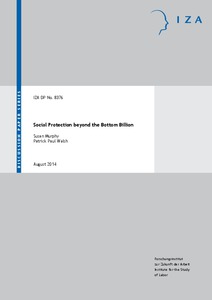Social protection beyond the bottom billion

Murphy, Susan ; Walsh, Patrick Paul
Institute of Labor Economics, Bonn
IZA - Bonn
2014
27 p.
equal rights ; poverty ; social protection ; social security ; social inequality
Discussion Paper
8376
Social protection
English
Bibliogr.
"Most conceptualisations of the bottom billion assume that "the poor" are a minority group in a state of continuous dependency, identifiable by region and demographic. Using a flow analysis (inflow and outflow) of poverty, rather than a stock analysis, we explain why poverty is more appropriately understood as a dynamic, with the majority of people flowing in and out of poverty for short durations. Distinguishing between structural and transitory poverty gives rise to a focus on the identification of multiple constituencies in the wider population including the permanently poor; sometimes poor; and non-poor. External shocks, including economic and environmental shifts, and risks such as ill-health, can affect any individual, household, or population in a non-predictable way, and can lead to loss of livelihood and a descent into poverty for various durations. At any point in time the bottom billion is made up of a blend of both transitory and structural elements with the former reflecting poverty as a risk for a much wider population than is often assumed. Using this analysis, the total stock of poverty potentially entails up to 5.1 billion people who do not have access to comprehensive social protection systems and are therefore vulnerable to spells in poverty. To protect against shared risks and mutual vulnerabilities, this paper argues that global insurance instruments, regulated through domestic institutions, would provide an efficient solution to transitory poverty. Further, it argues that these instruments could provide a foundation for investment in more equitable and extensive social protection measures that could target the multiple dimensions of structural poverty thereby seeking to ensure that no one is left behind."
Digital
The ETUI is co-funded by the European Union. Views and opinions expressed are however those of the author(s) only and do not necessarily reflect those of the European Union or the ETUI.